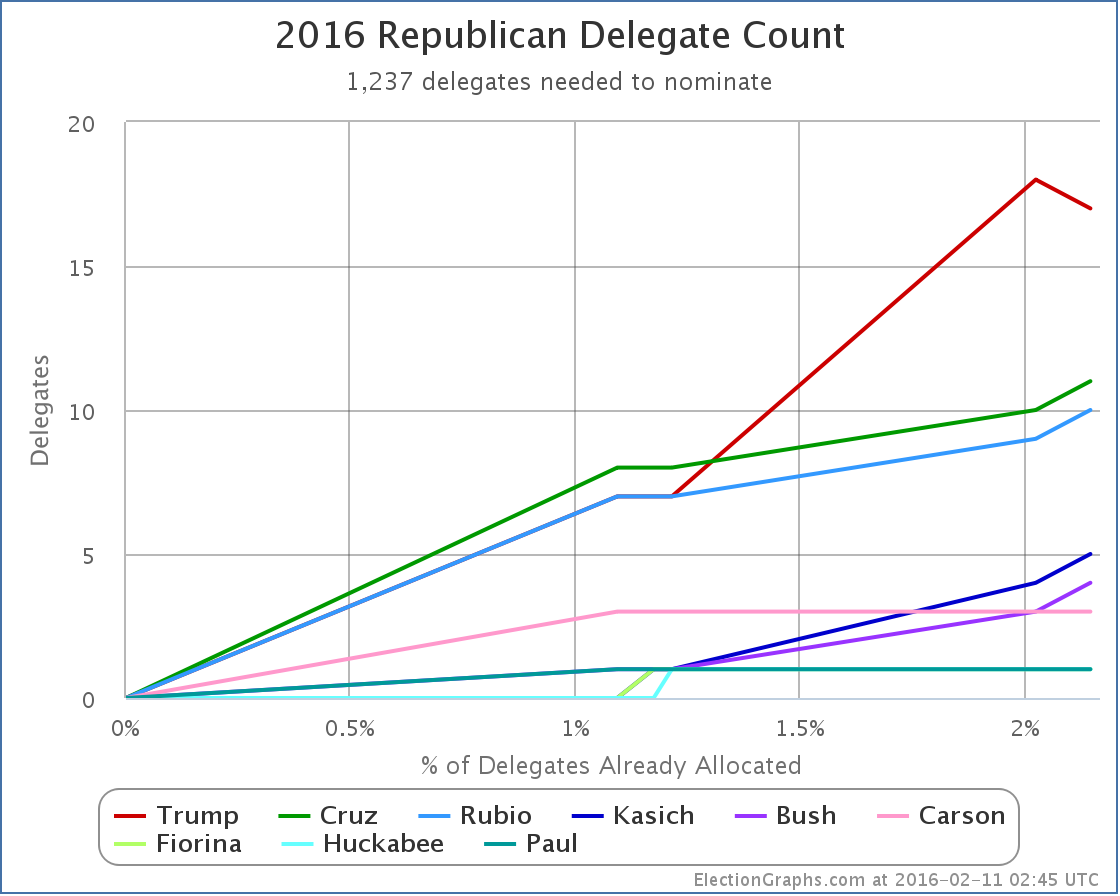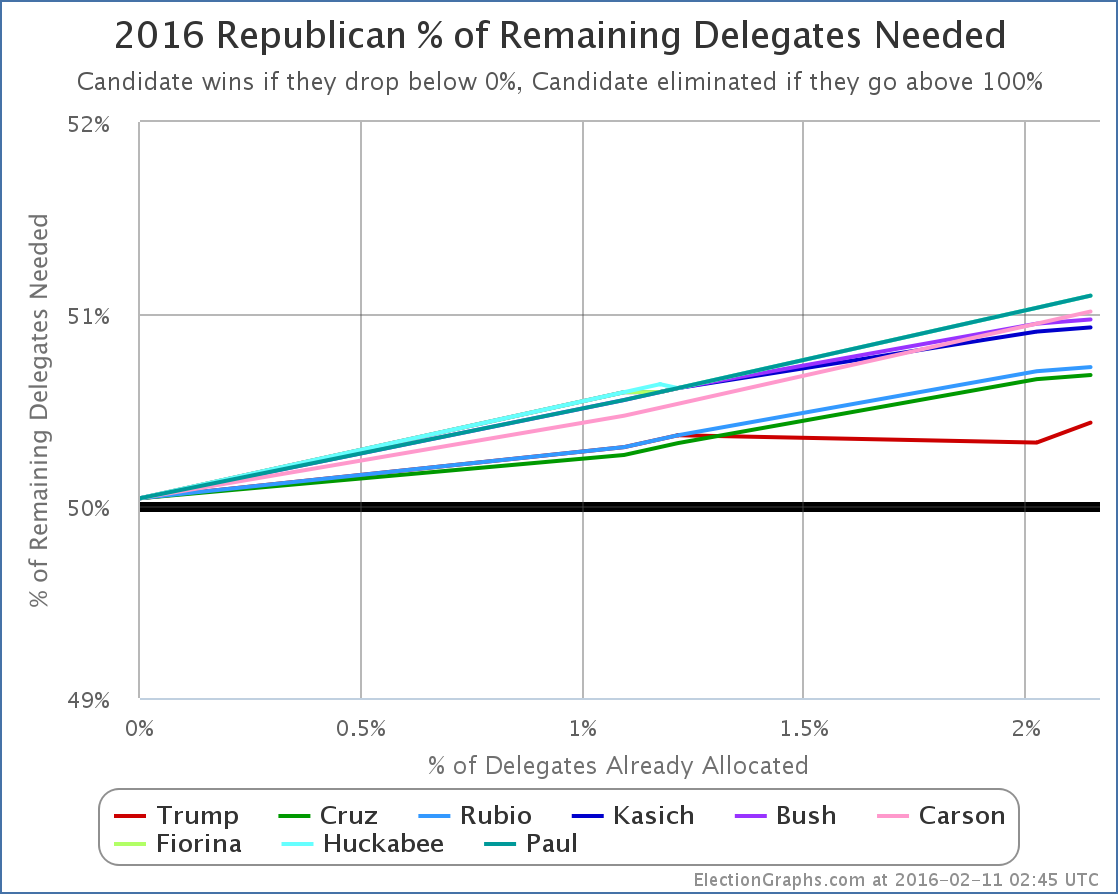I mentioned yesterday that the delegate totals were provisional and the counting wasn’t done yet. The counting is complete now, and in addition there have been some clarifications to the delegate allocation rules.
First on the rules, the way in which rounding is done was clarified. Instead of just rounding at the end, the percentages are rounded to a whole number first, and then the delegates are rounded to whole numbers at the end. This is a bit of a silly way to do it, because you are introducing the rounding distortion twice instead of just once, but that’s how New Hampshire chose to do it.
Then a rule change that affects not just New Hampshire, but all subsequent states too. Frontloading HQ has the scoop. The bottom line is that national RNC party rules changes are overriding rules at the state level about what happens to the three “automatic delegates” in each state. These are the National Committeeman, the National Committeewoman, and the chairman of the state Republican Party who all get to be delegates “automatically” based on their positions. In some states they were bound by primary or caucus results. In some states they were required by the rules to stay neutral. But in others, they were free agents. In the past the ones that were free agents had been the Republican party’s equivalent of the Democratic superdelegates. But the RNC national rule change is requiring these three automatic delegates to always be “bound” by the same rules that cover at-large delegates in each state.
So, essentially, no more superdelegates on the Republican side. All delegates will be bound by primary or caucus results. (There is still an exception for delegates who are directly elected by their own name apparently, but that is rare.)
For New Hampshire, when you consider final vote totals, and both rule clarifications, this changes the results from the primary from:
11 Trump, 3 Kasich, 2 Bush, 2 Cruz, 2 Rubio, 3 TBD
to:
10 Trump, 4 Kasich, 3 Bush, 3 Cruz, 3 Rubio, 0 TBD
The updated raw delegate chart showing this change is here:
The net result here is Trump loses one delegate, Cruz, Rubio, Kasich and Bush all gain one.
Trump is still clearly in the lead, but it does change his New Hampshire results in an important way. 11 out of 20 delegates was a majority, and above the threshold he needed to improve his “% of remaining delegates needed to win” number. 10 out of 23 is not a majority, and was not enough to improve his position on that metric:
If you look at full movement from before New Hampshire to these updated results, you can see that ALL of the candidates now got worse, as none of them got the level of delegate support needed to be on track for an outright win. Trump specifically went from needing 50.37% of the remaining delegates, to now needing 50.43% of the remaining delegates. This is much less of a change than the others of course, but it still went up.
So the statement I made in yesterdays update that “if Trump continues to match New Hampshire, he wins” is no longer true. If Trump (and the rest) continue to match New Hampshire, we are in for a contested convention.
Of course, we won’t see New Hampshire cloned in the subsequent states. We will see continued developments in the campaigns, more candidates drop out, and a very dynamic race continue to play out.
And fundamentally, the one delegate difference in Trump’s total doesn’t change the over all picture all that much.
I won’t repeat the details of yesterday’s post walking through scenarios for South Carolina and Nevada. If you haven’t already, go read it.
The bottom line is that unless there is a major change before South Carolina, it is very plausible that Trump walks out of it with a significant delegate lead. Updating for the New Hampshire changes above, that could look something like:
67 Trump, 11 Cruz, 10 Rubio, 15 Others
Nevada is more proportional, but will still give Trump a further opportunity to increase his delegate lead. Absent a surprise loss in South Carolina, he will almost certainly have a majority of the delegates allocated by then.
At that point, only 5.4% of delegates will have been decided. Lots of delegates left to play with.
But that is when things speed up. If the non-Trumps are going to consolidate support by all but one or two dropping out, it really should happen by the end of February, because 25.8% of the delegates will get decided on March 1st. And then another 30% or so in the two weeks between that and March 15th. When we pass March 15th, 60% or so of the convention delegates will have been decided.
If the anti-Trumps consolidated before then, it is possible that one of them will be leading instead of Trump. If the anti-Trumps are still divided though, then if Trump has managed to get over 50%, he’s almost certainly going to be the nominee. If he is leading, but under 50%, then talk of a contested convention becomes real, not just news junkie fantasy.
Absent the oft-predicted but never realized Trump collapse, for any of the other Republicans to beat Trump, all but one (MAYBE two) need to drop out and drop out quickly, and then they need to focus all of their effort on Trump. But for the moment, all the anti-Trumps are still squabbling with each other, leaving Trump to consolidate a lead while they are for the most part continuing to ignore him.
That is just a formula to anoint Trump. At some point people will drop out, and the race will narrow. The question is does it happen in time for whoever is the surviving anti-Trump to have a real chance.
Note: This post is an update based on the data on ElectionGraphs.com. Election Graphs tracks both a poll based estimate of the Electoral College and a numbers based look at the Delegate Races. All of the charts and graphs seen in this post are from that site. Additional graphs, charts and raw data can be found there. All charts above are clickable to go to the current version of the detail page the chart is from, which may contain more up to date information than the snapshots on this page, which were current as of the time of this post. Follow @ElectionGraphs on Twitter or like Election Graphs on Facebook to see announcements of updates or to join the conversation. For those interested in individual general election poll updates, follow @ElecCollPolls on Twitter for all the polls as they are added.
[Edit 2016-02-14 06:18 UTC to add end note.]


[Blog post] Republicans: New Hampshire Delegate Adjustments https://t.co/FbG3kJooeG
Reading – The GOP’s deadline problem (@SamWangPhD) https://t.co/Gi7cZLds5T – Matches my own analysis: https://t.co/utHjaUTTLM
RT @abulsme: Reading – The GOP’s deadline problem (@SamWangPhD) https://t.co/Gi7cZLds5T – Matches my own analysis: https://t.co/utHjaUTTLM